In Mumbai, Hindu weddings are a vibrant, intricate blend of age-old customs, familial love, and modern-day flair. Each ritual holds profound meaning, symbolising not just the union of two souls but of two families. At PK Photography, we believe that capturing these sacred moments is not just about clicking pictures—it’s about telling a story of love, tradition, and celebration.
From the pre-wedding events filled with joy and anticipation, to the grand wedding day itself, to the emotional post-wedding rituals, every step is a chapter in the couple’s unique love story. Here’s a deep dive into the traditional Hindu wedding ceremonies, explored through the eyes of a wedding photographer in Mumbai. If you’re an event planner, photographer, or family member planning a wedding, this guide will help you understand the cultural richness and the art of documenting every precious moment.
Pre-Wedding Rituals: Capturing the Start of the Journey
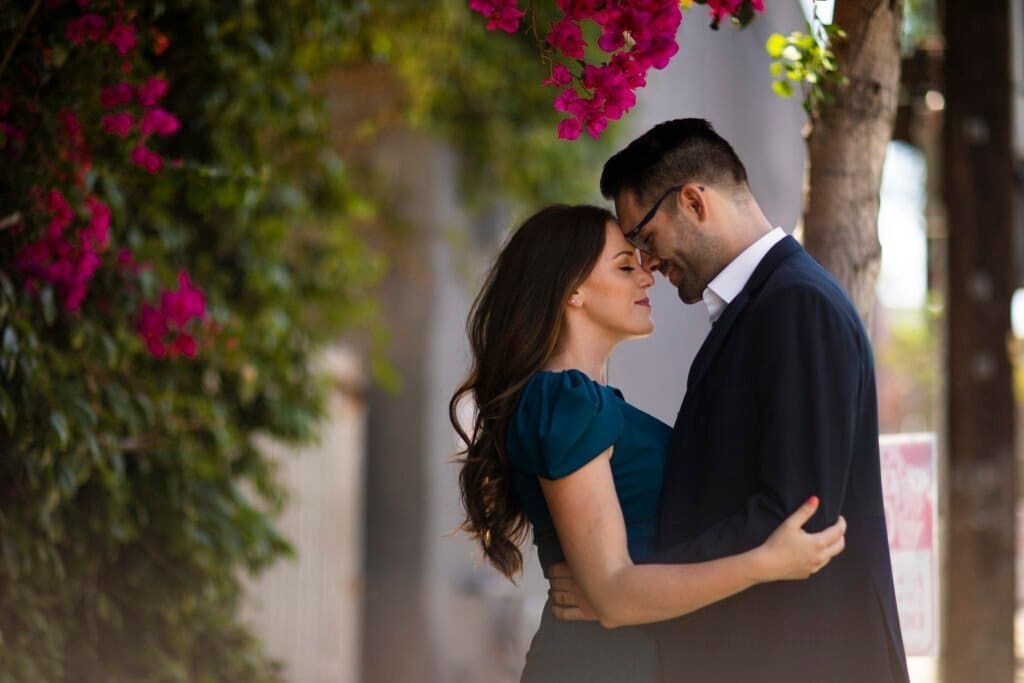
Tilak Ceremony The bride’s family visits the groom’s residence and applies a tilak (vermilion mark) to the groom’s forehead, symbolising their acceptance of him. The ceremony strengthens familial ties and is considered a blessing for a prosperous union.
Haldi Ceremony: A Splash of Sunshine
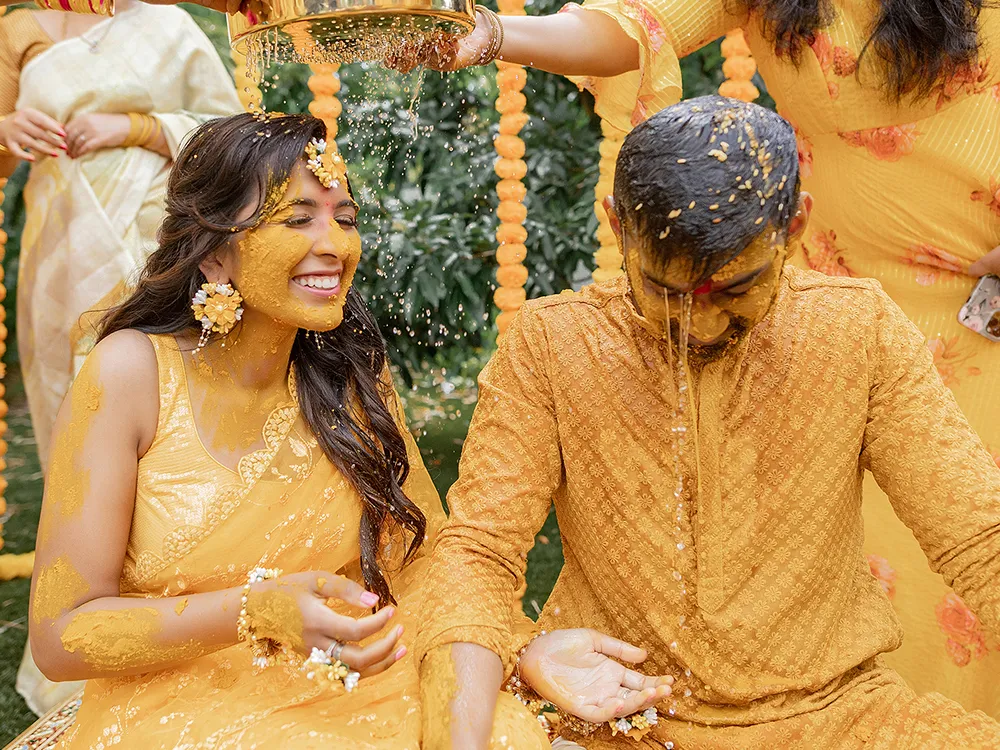
The Haldi ceremony is where the bride and groom are bathed in turmeric paste, symbolising purification and a blessing of good fortune. As a photographer, this event offers an incredible opportunity to capture candid shots bathed in golden hues. Natural lighting can work wonders here, so always be ready to snap moments of laughter as the bride and groom are covered in Haldi by their loved ones.
Tip: Focus on the raw emotions and playful energy during Haldi. Using a zoom lens to capture intimate close-ups can make for heartwarming photographs.
Mehendi Ceremony: Intricate Beauty

The Mehendi ceremony is a celebration of artistry where the bride’s hands and feet are adorned with elaborate henna designs. This is where macro photography shines. Every swirl, flower, and delicate stroke of the Mehendi can be immortalised in rich, detailed shots.
Photographer’s Note: The bride’s reactions during this ceremony are equally significant—catching her glances at her intricately decorated hands makes for stunning portraits. Don’t miss out on shooting candid family moments too, as these interactions often bring out the warmth and closeness among relatives.
Sangeet: The Night of Dance and Music
The Sangeet is a night filled with exuberant performances, laughter, and dance. Families come together for a night of singing and dancing, making it one of the liveliest and most dynamic ceremonies to shoot.
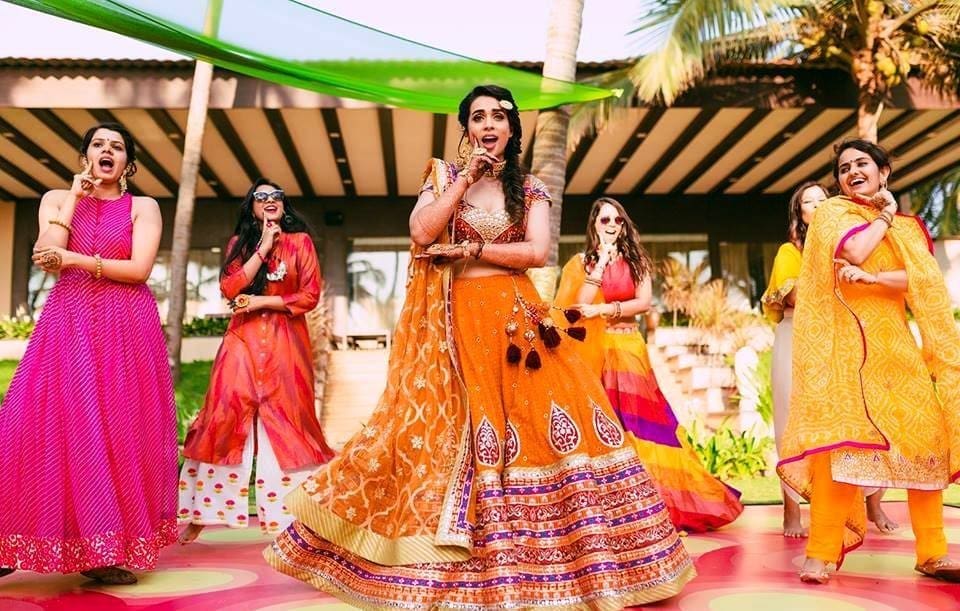
For photographers, capturing the essence of the Sangeet means being on your toes. Dance sequences, musical performances, and candid moments of guests enjoying themselves create an electric atmosphere. Wide-angle shots of the entire dance floor combined with close-ups of expressive faces help create a vivid narrative of the night.
Tip: Use a mix of slow shutter speeds to capture motion blur, especially for dance movements, adding a dynamic touch to the Sangeet album.
Wedding Day Rituals: Immortalising Tradition
Baraat: The Groom’s Grand Entrance
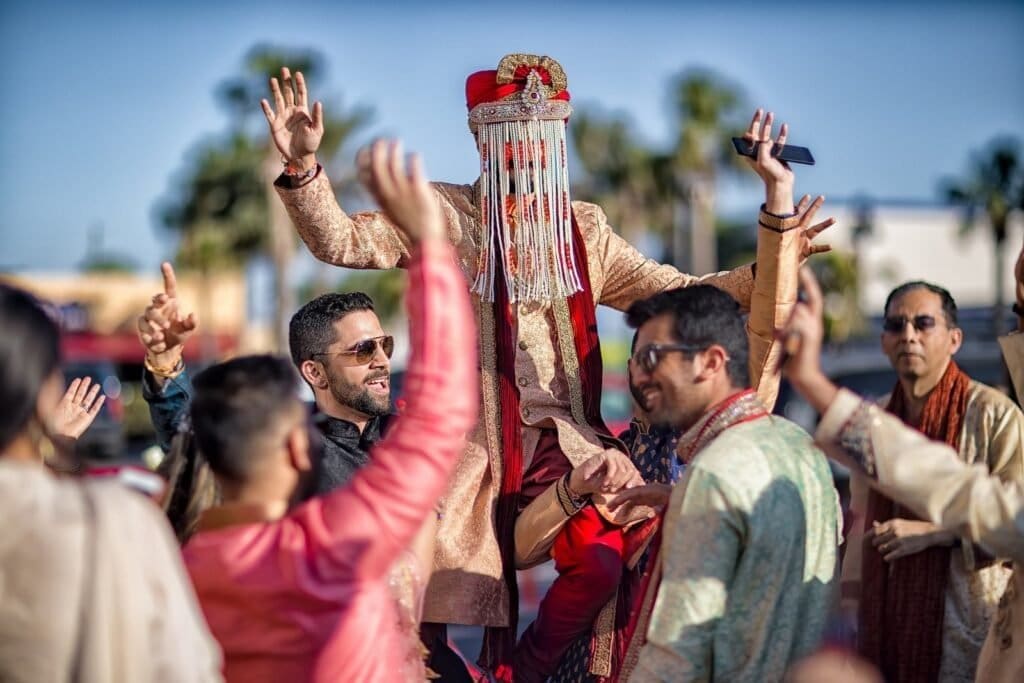
- Baraat (Arrival of the Groom) The wedding day officially begins with the Baraat, where the groom arrives at the venue in a procession, typically on a horse, accompanied by friends and family dancing to the beats of dhols (drums). It’s a fun-filled event that provides excellent opportunities for lively photography. Upon reaching the venue, the groom is greeted by the bride’s family.
Photographer’s Insight: Capture the energy and joy of the Baraat—freeze-frame the dancing guests, the groom waving to his family, and the infectious happiness in the crowd. Be agile and ready to shift between wide shots of the entire procession and close-ups of individual expressions.
- Dwar Puja As the groom arrives, Dwar Puja is conducted. The bride’s mother applies tilak to the groom’s forehead, welcoming him into the family. This ritual sets the tone for the sacred ceremonies that follow, and the emotional exchange of respect and love offers photographers touching moments to capture.
Varmala: A Moment of Union
- Jaimala or Varmala (Exchange of Garlands) The Varmala marks the official beginning of the wedding ceremony, where the bride and groom exchange flower garlands. This ritual symbolises their willingness to accept each other as life partners. It’s a moment filled with love and laughter, often made playful by friends lifting the groom to prevent the bride from placing the garland on him easily
Photographer’s Tip: Stand at an angle that allows you to capture both the bride and groom’s expressions during the exchange, and don’t forget to document the family’s reactions—they’re often filled with joy and excitement.
The Reception: A Grand Celebration
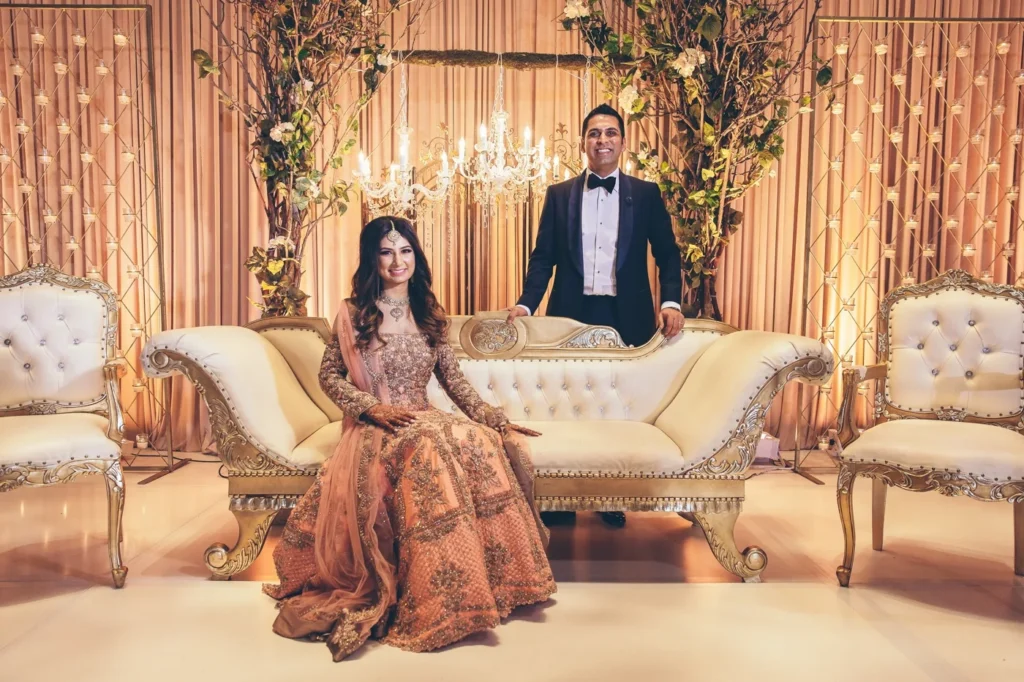
After the emotional Varmala, the reception is typically held as a more formal event where the couple meets extended family, friends, and acquaintances. It’s a night of fine dining, speeches, and celebration.
For photographers, this event is an opportunity to capture a mix of candid and posed shots. Formal family portraits and candid photos of guests interacting are both essential elements of this part of the event.
Tip: Use soft lighting to enhance the elegance of the setting. Capturing the décor—whether it’s floral arrangements, chandeliers, or the couple’s seating area—adds context to the overall visual story.
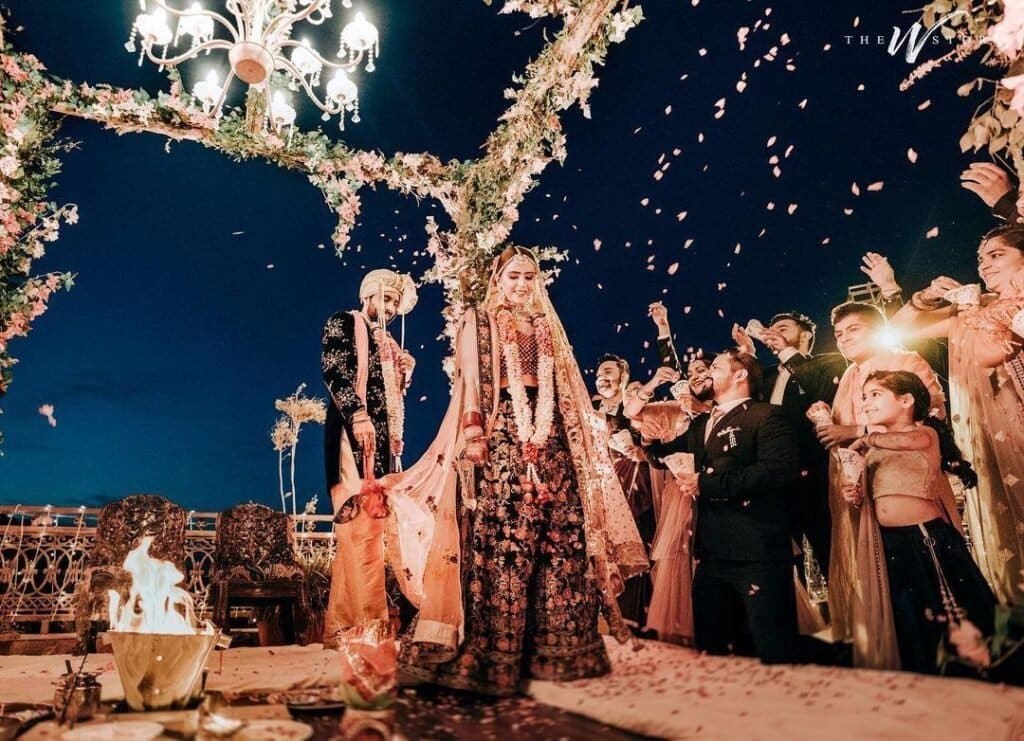
- Mandap Ceremony (Sacred Rituals at the Mandap) The heart of a Hindu wedding takes place at the Mandap, where the priest performs the sacred rituals. The couple sits before the holy fire (Agni) as the priest recites mantras. Key rituals include:
- Panigrahana: The couple holds hands in front of the fire, symbolizing their union.
- Saptapadi (Seven Steps): The bride and groom take seven steps around the fire, representing seven vows they make to each other, which include promises of love, respect, fidelity, and support
These moments are profound and are crucial to document, showcasing the intricate details of the rituals and the spiritual connection shared between the couple.
- Sindoor and Mangalsutra After the pheras, the groom applies sindoor (vermilion) to the bride’s hair parting and ties the mangalsutra (a sacred necklace) around her neck, symbolising her status as a married woman. These actions solidify the marital bond, and the moment is both sacred and emotional, ideal for close-up shots that capture the intimacy of the moment
- Kanyadaan (Giving Away of the Bride) One of the most emotional moments during a Hindu wedding is the Kanyadaan. The bride’s father places her hand in the groom’s hand, symbolising the father entrusting his daughter’s happiness to her husband. This poignant ritual brings out deep emotions and creates a beautiful narrative for Wedding Photography in Mumbai, especially in candid moments of family love and bonding.
Bidai: The Emotional Farewell
After the wedding rituals are completed, the Bidai marks the departure of the bride from her family home. It’s one of the most emotionally charged moments, filled with tears, hugs, and goodbyes.

Photographer’s Tip: Be unobtrusive but present. Capture the genuine emotions of the bride and her family. Look for the small gestures—tears, held hands, a father’s comforting hug—that convey the depth of this moment.
Post-Wedding Rituals: Capturing New Beginnings
Once the wedding is over, some families celebrate with a small ritual to welcome the bride into her new home. These rituals, though brief, are filled with meaning and are an essential part of the wedding narrative.
For photographers, it’s important to remain attentive even after the main events. These moments might not be as grand, but they’re intimate and deeply emotional.
Common Questions About Hindu Wedding Photography in Mumbai
Q1: How do photographers handle multiple ceremonies during a traditional Hindu wedding in Mumbai?
Photographers at PK Photography usually work in teams to cover every aspect of the event. For larger weddings with multiple rituals happening simultaneously, we assign different photographers to each ceremony. This ensures nothing is missed, and every significant moment is captured in full.
Q2: What are the best photography styles for Hindu weddings?
For Hindu weddings in Mumbai, a combination of candid and cinematic photography works best. The candid style captures spontaneous moments and raw emotions, while the cinematic style adds drama and grandeur to key moments like the Varmala and Saptapadi. At PK Photography, we excel in both styles, ensuring a beautiful mix of natural and artistic photos.
Q3: How do you ensure the couple’s preferences are incorporated into the wedding photography?
We hold pre-wedding consultations with the couple to understand their preferences. Whether it’s a particular ritual they want to highlight or a specific style of photography, we tailor our approach to meet their vision.
Q1: What is the significance of the Saptapadi ritual? A: The Saptapadi (seven steps) is the most sacred part of the Hindu wedding, symbolizing the couple’s journey together. Each step represents a vow, ranging from promises of loyalty, friendship, and support to vows for health, happiness, and prosperity.
Q2: Why is the Varmala ceremony important in Hindu weddings? A: The Varmala (garland exchange) is one of the first steps in the wedding ceremony. It represents the mutual acceptance of the bride and groom as partners in life. This moment is often filled with playful fun, especially when friends lift the groom to make it challenging for the bride to place the garland.
Q3: What are “getting ready” shots, and why are they important? A: Getting ready shots are essential in capturing the excitement and anticipation before the main ceremony. These shots include candid moments of the bride and groom preparing for their big day, showcasing the details of their attire and the emotional support of their loved ones.
Q4: What is the significance of the Vidaai ceremony? A: The Vidaai is an emotional farewell where the bride leaves her parental home to start a new life with her husband. This moment marks the culmination of the wedding day and the beginning of her new journey. It’s a poignant, tear-filled moment that’s rich in emotion and perfect for candid photography.
Q5: How can I ensure all the rituals are captured on my wedding day? A: Hiring a professional photographer who understands the flow of Hindu weddings is essential. At PK Photography, we specialize in covering both big and small moments, ensuring that nothing is missed, from candid moments during the Haldi ceremony to intimate portraits after the Varmala.
Q6: What makes Wedding Photography in Mumbai unique? A: Wedding Photography in Mumbai is unique because of the city’s diverse backdrop, blending modern urban landscapes with traditional cultural settings. Mumbai’s vibrancy adds a special flavor to wedding photos, making them timeless and memorable.
